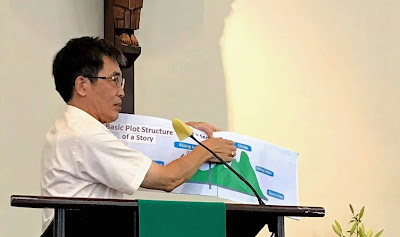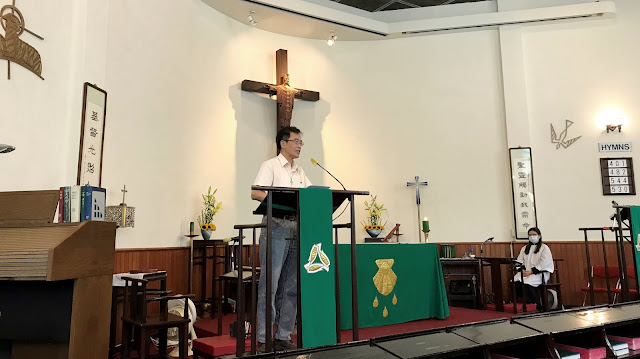#2020-0816
for the 11th Sunday after the Pentecost
(Only talking about Matthew 15:21-28)
Let us pray.
Let the words of my mouth and
the meditation of my heart be acceptable in your sight, O Lord, my strength and
my redeemer. – Psalm
19:14
Be seated.
The Faith of
the Canaanite Woman
Today, on the 11th Sunday after
Pentecost, we continue our Pentecost tour through Genesis, Romans,
and the parables and stories of Jesus in the Gospel of Matthew. We have
two unsettling encounters: the meeting of Joseph and his brothers, and the
meeting of Jesus and the Canaanite woman.
Since I am not a professional preacher, it would
be better, or easier, for me to narrow down the scope of what to preach for
today. Let’s just focus on the story told in Matthew 15:21-28, about the
Canaanite mother asking Jesus for help and about her great faith in the Lord
(whom she called “Son of David”) when she pleaded with him to save her
daughter.
I chose this story to discuss because it’s like a
rare and strange picture, making me curious at first, and then confusing me
quite a bit: I tried to explore the meaning of the story but for a long time I
felt I couldn’t interpret it in a good way!
In my impression, Jesus is always kind and
loving, willing to help, and even very friendly with tax
collectors, the outcast, and the demon-possessed. Jesus is so
good; he’s perfect for me. But hearing the odd confrontation between Jesus and
the woman in today’s gospel reading, if I had not found any explanation of it, I
would have blurted out this: “What’s going on? What’s wrong with the author of
the Gospel of Matthew? Is the teacher described in this passage really our Lord
Jesus?”
At least for some of us here, it’s easy to assume
that there is something wrong in the
story we’ve just heard. But our Lord is perfect for us; he must be (and should
be) perfect -- in word and deed. Could he have said those harsh words to the Canaanite mother as described in Matthew?
Well, I used to be a high-school teacher, and I
had been interested in literature before I became a teacher. About 35 years
ago, when I was studying in NTNU (National Taiwan Normal University), I took a
selective course named Biblical Literature (聖經文學), studying the Bible as literature. So in this
past week, while preparing a sermon for today, I thought to myself: “Maybe I
should review this story in detail – in more detail. If I do ... if I do it
hard and right, maybe I can find something new, and something interesting!”
Obviously, the
story of the Canaanite Woman’s Faith has a difficult part in it. It’s no easy
job to catch the whole meaning of the
story, and it’s especially hard to understand the harsh words that Jesus used to respond to the Canaanite woman.
However, in terms of structure, this is a complete and well-organized story: it
has its beginning, middle parts, and a perfect end.
(Show the
Basic Plot Structure of a story.)
Like the basic plot structure of a short story,
you can clearly see:
² Exposition – the beginning of the story where characters
and setting are introduced. E.g. Vss. 21, 22a.
² Rising action – where the main character faces a series of conflicts; the rising action
contains inciting incident(s), conflicts, struggles, and crises.
E.g. Vss. 22b, 23, 24, 25, 26.
² Climax (the turning point) – the most exciting part of the story; showing
whether the battle is won or lost. E.g. Vss.
27, 28a.
² Falling action (the aftermath or results) – events leading to the end of the story. [In the
mentioned story, there’s no Falling Action to be seen!]
² Resolution or denouement /ˌdenuˈmɑŋ/ – the end of the story; problems and conflicts (usually) resolved, goal
reached (or not). The “new normal” is now in place. E.g. Vs. 28B.
From a Chinese point of view, we have a well-known
Four-Stage (or Four-Part) Structure called “起qĭ, 承chéng, 轉zhuăn, 合hé.” These
four structural parts (qĭ, chéng, zhuăn, hé) can be seen in our literary and artistic
creation, for example in an essay, a story, and some other types of writing composed
in Chinese. Now the story of the Canaanite Woman happens to be a good example comprised
of these four structural parts:
Part 1, 起 (Start / Opening); see Vss. 21, 22.
Part 2, 承 (Continue / Carrying on);
see Vs. 23.
Part 3, 轉 (Change / Turning); see
Vss. 24, 25, 26, 27.
Part 4, 合 (End / Closing); see Vs. 28.
In Chinese
literature this four-part structure has been applied not only to essay-writing
and story-writing, but also to poetry composition, because it is regarded as a graceful
form in literature and arts.1
Anyway, we’re not only enjoying a graceful form.
There has to be something meaningful and important contained in the form; that
is, the content, the valuable thing inside. As we notice beautiful (or
eye-catching) language in the Bible, we also want to pay attention to the
meaning – the real meaning – or what
we call the “truth” that is conveyed in words, in the language, in parables and
stories from the holy book.
Now what do we see and what can we learn from
today’s gospel reading? Let’s review the story and take a closer look at it:
Jesus and his disciples went from Galilee into the
district of Tyre and Sidon, which was a Gentile region. Then a woman came and asked
him to heal her daughter. -- No problem! It sounds all right here.
But Jesus did not say a word to her. -- Why not?
The woman continued; she kept shouting after Jesus
and the disciples. Finally, Jesus announced that he had been sent only to
the Jews – not Gentiles like her. He dismissed her. -- Why?
The woman would not give up. She knelt before
Jesus and said, “Lord, help me.” Jesus answered, “It is not fair to
take the children’s food and throw it to the dogs.” -- Oh, why did he call her a dog?
Still, with courage and desperation, the woman
persisted. “Yes, Lord, yet even the dogs eat the crumbs that fall from their
masters’ table.” Finally, the story (which is like a “rare and strange”
picture, as I said earlier) … the picture begins to make sense. Jesus commended
her and affirmed her as a beloved child of God, saying, “Woman, great is
your faith! Let it be done for you as you wish.” (= You are a woman
of great faith! What you want will be done for you.)
And her daughter was healed instantly. -- Hooray! What
a perfect end! The end of the story is very happy and exciting, isn’t it?
But wait! … Confusion needs to be clarified; those
questions in our mind need to be answered. Why did Jesus keep silent at
first? Why did he say he had been sent only to “the lost sheep of the
house in Israel”? Why did he call the pagans “dogs”?
For centuries, many attempts have been made to
make sense of those Why’s. As far as
I know, there are at least three ways to solve the problems mentioned above.
First, some scholars say that the Greek word Jesus
used for “dog” really means “puppy.” Puppies are cute little dogs. We Chinese
parents call our children “xiăo quăn” (小犬) meaning little dogs, just as English speakers
use the word “kid” to refer to a child, though “kid” also means a young goat.
So Jesus was using the word dog as a metaphor
that is not very embarrassing.
Second, many people would suggest that it was
all a test, that Jesus treated the woman harshly in order to test his
disciples’ understanding of God, or perhaps because he wanted to test
the humility and faith of the Canaanite woman. Or maybe he was saying to
the woman, “My disciples regard Gentiles as dogs. Now what do you and I have to
say about that?”
The third theory (or hypothesis), which is most convincing
to me, is explained by the Rev. Ken Kesselus2 in his recent
sermon. To cut a long story short, this is, as Rev. Ken says, “a story that
comes from an early time in Jesus’ ministry and demonstrates a stage of growth
in the development of his understanding of God’s universal values.”
Rev. Ken wants his audience to imagine: “Imagine
that this story is literally true as told – that there is no hidden meaning, no
symbolic understanding, no false reporting of the encounter between the woman
and Jesus. Imagine that what Jesus said and did in this story reflects exactly
what he believed – at the time.”
Now, let us imagine how much
love and faith was in the Canaanite woman’s heart. In order to save her
daughter, this mother would never give up; she kept begging Jesus to heal her terribly
sick child, knowing that only he
was able to heal.
And let’s also imagine (and find out) what wonderful
consequences have resulted from the meeting of Jesus and the women. If Rev. Ken’s
guess is correct (his arguments being quite reasonable!), Jesus must have made
an important decision, or a big change, during the conversation with the woman.
In those few minutes, he whom the woman called “Son
of David” realized that his mission had expanded. He had wanted to break through
the “boundaries” of the Jews and the Gentiles, so that even the dogs could enter the same realm as the children.
Yes, Jesus our Lord did not come just for the children of Israel. His mercy extends to everyone. Again, being one of the three Persons of the Trinity God, his mercy is so abundant; his healing and love over flow; and there is enough for not only the children of Israel, but also for the entire world. (Praise the Lord. Amen.)
= = =
Notes:
- Quite a number of traditional poems in Chinese (especially jueju, Chinese quatrains, a type of jintishi, “modern form poetry” that grew popular in the Tang dynasty, 618-907) are in this four-part structure: “qĭ, chéng, zhuăn, hé."
- The Rev. Ken Kesselus, author of John E. Hines: Granite on Fire (Episcopal Theological Seminary of the Southwest, 1995), is retired from full-time, active ministry and lives with his wife, Toni, in his native home, Bastrop, Texas.




















沒有留言:
張貼留言